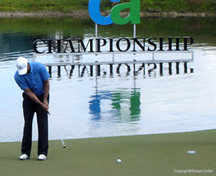Instant Golf® Special Report – Adam Scott’s Putting Strategy
It has been a few weeks since the Masters tournament and I don’t think there was a golf fan on the planet who wasn’t happy for Adam Scott after his breakthrough performance. He’ll be in action again this week at The Players Championship, an event he won in 2004.
 Adam has long had one of the most admired golf swings on Tour, especially amongst his peers.
Adam has long had one of the most admired golf swings on Tour, especially amongst his peers.
But his putting over the years had been a different story.
Adam’s demise at the British Open last year, 4 bogeys in the final 4 holes, concluded with a putted ball missing on the low side of the hole.
It had been a pattern in his game, even before the long putter. In fact a few years ago he was ranked dead last in putting on Tour.
Even with advanced greens charting, practice rounds, and playing the same courses year in and year out, Adam and plenty of other PGA pros still miss on the low side of the hole, especially under pressure.
Had caddy Steve Williams not read the break correctly on the 2nd hole of sudden death at The Masters, another major may well have slipped through Adam’s hands.
Steve saw considerably more break in the winning birdie putt than Adam, in fact he saw twice as much. In his words, ‘It’s at least two cups, it’s going to break more than you think’. The ball still snuck in the left center (low side), even with the extra break allowance.
 The “low miss” pattern has also long been the plague of the recreational golfer.
The “low miss” pattern has also long been the plague of the recreational golfer.
Why is it that recreational golfers miss putts on the low side or “amateur” side of the hole much more that the pros?
Why can’t they read break correctly, and hit putts the right speed?
The following will address that question and then I will offer a solution that will have you making more putts immediately:
1) First, when most golfers are faced with a breaking putt, they play “some break” because they know some break is needed. That’s all they know.
The average golfer just doesn’t have the same putt enough to know the correct break allowance. That lack of familiarity typically leads to missing on the low side.
What’s more, the more break that is required from putt to putt, the less they will play (as a % of the total break needed for a particular putt). This is especially true as the putts get longer.
Now add in the following points and missed putts will continue to be the order of the day:
i) Uphill putts will break more, and will bend away from the hole as if being pulled by a string. Most golfers leave putts short, ala the saying “Never Up, Never In”.
ii) The average golfer will also be extra tentative on downhill putts because they don’t want a long follow-up putt. So they will under play the amount of break needed.
You see, putts that are hit with minimal break allowance have only 2 entrance paths or “gates” into the hole, low and middle. Adam’s birdie on 18 before the playoff barely trickled in the low gate. Watch it again, he was extremely lucky!
 Putts hit with maximum or correct break have 3 gates into the hole. I diagram this in “Putting Rebel – Conversation with a Putting Wizard”. If you have “Putting Rebel”, refer to it before the next time you play.
Putts hit with maximum or correct break have 3 gates into the hole. I diagram this in “Putting Rebel – Conversation with a Putting Wizard”. If you have “Putting Rebel”, refer to it before the next time you play.
If you don’t, “Putting Rebel” comes as a free bonus with “The Key To A Repeating Golf Swing” package below. It is a based on a conversation I had with the best putter I have ever played with in all my years in the game. It is eye opening.
Now, Steve Williams, arguably the most successful caddy of all time, gave an excellent clue on break reading in his comment to Adam.
It has been my conclusion, not only in my own game, but having played with countless pros and recreational golfers, that:
Recreational golfers should generally Double
the amount of break they see in any putt.
Yes, 100%, or 2X more.
As the putts get longer, this is especially important as unseen imperfections and nuance in the greens “eat up” the ball’s momentum, resulting in low side misses or lip-outs.
 And I’ll conclude by saying that Tiger Woods, love him or hate him, has separated himself from the pack over the past 17 years by having the confidence to putt fearlessly.
And I’ll conclude by saying that Tiger Woods, love him or hate him, has separated himself from the pack over the past 17 years by having the confidence to putt fearlessly.
He guns for the high side of the cup like few golfers in history, and has 104 worldwide wins since turning pro in 1996.
So before you play, arrive early and hit the practice green. Double the break you see, particularly on long putts. You’ll be warming up not only your stroke, but your eyes and intuition.
You’ll also be getting a glimpse of green speed and condition for the actual course you are about to play. Converting your best iron shots into drained putts is a great reward.
To learn “The Key To A Repeating Golf Swing”, and receive 5 bonuses including “Putting Rebel”, and my new Spring 2013 Ball Rec Reports, visit below for full details:
Best Regards,
About the Author: Robert Cotter is a US patent award winning golf ball design engineer and fine player. His interaction with the top players in the game led to his discovery of The Key to a pro caliber golf swing. He is the author of “The Key To A Repeating Golf Swing” which has taught over 5000 golfers in 60+ countries.
